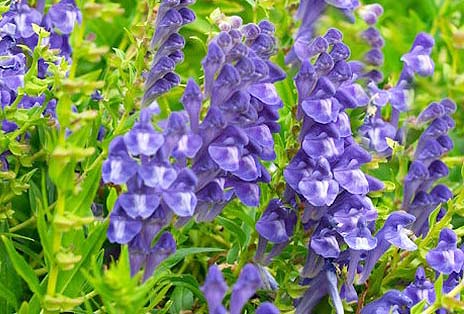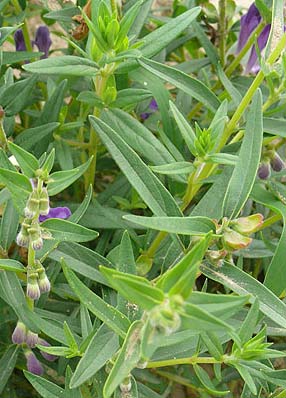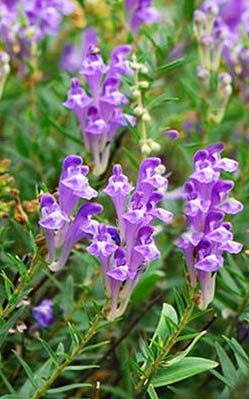Festooned with bright blue flowers from late spring/early summer until early fall this tough low lying perennial plant is a delight in the garden. Easy to grow from seed and fairly drought tolerant once established. Its not fussy about soil type provided its well drained. Baical skullcap needs very little maintenance. Its best in full sun but will tolerate some shade in zones 7-8. Flowers profusely from the second year onwards it's a great plant to have next to walkways and high traffic areas where its bright color can be appreciated.
Description of Baical Skullcap (Scutellaria baicalensis).
Tough creeping perennial plant hardy to zone 4 that dies down in winter. In
spring it sends up a cluster of fairly slender, square shaped stems which quickly
branch and can reach 6 - 18 inches (30-90 cm) in height. The leaves are narrow
lance shaped mid green ½ - 2 ½ inches (1-6 cm) long arranged in
opposite pairs all along the stems. Flowers are produced at the axils of these
leaf pairs all along the stems. They are tube shaped, hooded, with two lips,
the upper lip being the hood and the lower lip having two shallow lobes, usually
bright blue in color but can be lavender or rarely pink. After pollination the
top section of the flower closes over the lower section to give the appearance
of a capsule with a lid, this splits into two sections when the seeds are ripe
allowing dispersal. The roots are yellow to ocher in color often fibrous with
a central tap root. The calyx at the base of the flowers is in the same shape
as the medieval helmets worn in Europe which is where the name "skullcap"
is derived.
Growing Baical Skullcap (Scutellaria baicalensis) from Seed.
baical skullcap is very easy to grow from seed and needs little extra care.
While it can be sown directly we usually recommend starting indoors for better
control. Follow our general growing instructions and seeds should germinate
in 10 - 20 days. Keep seeds moist at all times but not wet. Transplant to individual
pots when large enough to handle and grow on until plant is sufficient size
to be transplanted to its final location. Ensure that plants are hardened off
for full sun exposure before transplanting.
How were your seeds treated before you obtained them?
How well your seeds germinate will depend on how they were treated before you
obtained them. Many skullcaps prefer a period of cold before they germinate.
All our seeds have been pre-chilled and kept at a cool temperature to make germination
easy. Our seeds usually germinate within 10-20 days without special attention.
However if your seeds were not cold treated before you obtained them you may
need to stratify them
and they make take a considerable time to germinate. Some sources state that
their seeds may not germinate for as long as 20 weeks or even longer.
Location and Care of Baical Skullcap (Scutellaria baicalensis).
Prefers full sun and is not really fussy about the soil type provided it is
well drained. Does not do well in heavy clay soils that do not drain or any
soil that stays wet. It is low growing so makes an excellent front border plant
especially next to pathways where its prolific flowering can be fully appreciated.
Space plants at least 12 inches (30 cm) apart and keep slightly moist for the
first year while the plant is establishing itself after this it is usually quite
drought tolerant and will not need much additional water provided there is not
prolonged drought.
Can take partial shade in zones 7-8 but should be given full sun in zones 6 and higher. As this plant usually produced tap roots it suffers badly if transplanted so choose your location with care. Once established the plant will flower prolifically year after year with little care or maintenance. Cut down in winter, some mulching is suggested in zones 4-5. Often flowers in the first year but will become more prolific from second year onwards.
Harvesting Baical Skullcap (Scutellaria baicalensis).
Leaves. Can be harvested from mature plants when the plant begins to
bloom. Used the top sections of the stems. They can be used fresh or dried.
Roots. Can be harvested from the third year onwards in the late fall
or
early spring. Good quality roots should be bright yellow to ocher not any
other color.
Both roots and leaves can be dried for later use.
Culinary Uses of Baical Skullcap (Scutellaria baicalensis).
The young leaves can be cooked as a vegetable or used as a tea substitute.
Medical uses of Baical Skullcap (Scutellaria baicalensis).
Baikal skullcap root is considered one of the 50 fundamental herbs used in Chinese
herbalism used primarily to treat 'hot and damp' conditions. These would include
dysentery, diarrhea, and urinary tract infections but it is also used for a
myriad of other conditions including jaundice, chronic hepatitis, hypertension,
enteritis, threatened miscarriage, nosebleed and haemorrhage from the lungs
or bowel. It is purported to greatly enhance liver function and calm the fetus
in pregnant women. It is also an reported as an effective antibacterial treatment
for staph (Staphylococcus aureus) infection and used to treat avian flu.
The roots also contain compounds that have been confirmed as a sedative and
the herb works as a mild relaxant for anxiety, nerves and convulsions. It was
also at once time used as a treatment for rabies hence the common name 'mad
dog' however we can find no reports on how successful this treatment was.
Other names.
Huang-qin, scullcap, hoodwort, quaker bonnet, helmet flower, European skullcap,
greater skullcap, blue skullcap, blue pimpernel, hoodwart, hooded willow herb,
side-flowering skullcap, mad dog weed, and mad weed, Baikal skullcap
Common name spelling.
Baical Skullcap is also spelt Baikal skullcap all across the internet. Which
is correct? It's hard to tell. However since the Latin name is Scutellaria
baicalensis it seems more logical that baical is correct and the use of
the 'k' is a misspelling that has been perpetuated.








